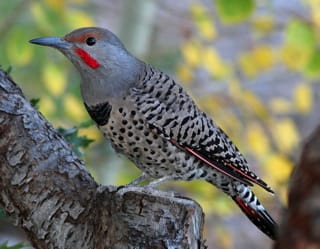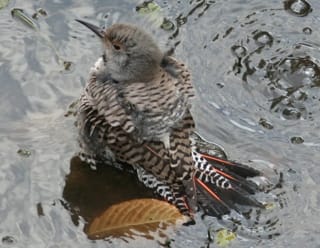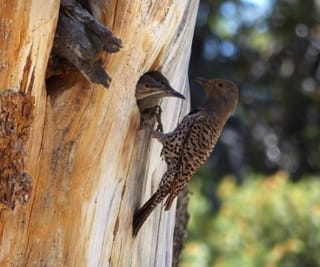Initially this guide displays common birds of all types that are flying right now in our area. Use the selectors below to view rare birds, view birds flying any time, restrict the output to a certain shape of bird, or search by name.
New Mexico is on the western edge of the Central Flyway which is one of the major migration pathways between north and south for birds traveling between breeding and wintering grounds along the Rocky Mountains. This has resulted in the state having an incredible diversity of birds with over 550 different species reported. A little more than half of this number are sighted annually on the Pajarito Plateau. Some of these birds are full-time residents, some migrate here for a few weeks or months, and other are only seen briefly as they pass through the region.
This guide features many of the birds known to frequent Los Alamos county by when they are likely to be seen in the area. You can get additional information on local birds by joining PEEC Birders or going to the eBird website. eBird also includes lists of rare bird sightings and birding hot spots.
Bird References
Birdweb
Cornell Lab of Ornithology
eBird
eNature
Institute for Bird Populations
National Audubon Society
New Mexico Ornithology Society
What Bird
xeno-canto
Subject Area Experts (all guides)
Steve Cary (butterflies)
Beth Cortright (insects)
Terry Foxx (invasive plants)
Leslie Hansen (mammals)
Richard Hansen (fish, mammals)
Dorothy Hoard (butterflies, trees)
Chick Keller (flowers, herbarium)
Shari Kelley (geology)
Kirt Kempter (geology)
Garth Tietjen (reptiles)
David Yeamans (birds)
Web Development and Content Management
Pat Bacha
Jennifer Macke
Graham Mark
Akkana Peck
Contact
Please contact us for local nature questions and sightings. We welcome comments, corrections, and additions to our guides.
For more information about local nature, please visit our Nature Blog or subscribe to PEEC This Week.
Make Selection
 Photo: male by Hari Viswanathan  Photo: female by Selvi Viswanathan  Photo: nest with young by Emma Wynn |  Northern FlickerNOFL (Colaptes auratus)Family: Picidae (Woodpeckers) Size: 12 in (30 cm) Flies: Jan 01 - Dec 31 Morphology: two forms exist with different colored flight-feather shafts (yellow versus red); local adults have red flight-feather shafts, curved bills, stiff tails often used as a prop, brownish bodies with black spots and bars, gray heads, and white rump patches; males have a red mustache stripe; females lack the mustache Status: native; common Food source: insects, including ants, beetles, termites, and caterpillars; will eat fruits, berries, seeds, and nuts at times Habitat: open country with trees, parks, residential areas Northern Flickers are ubiquitous in the local area. They commonly forage by hopping on the ground but also climb trees searching for wood-boring, using their bills to dig the them out. Flickers have sticky, barbed tongues that extends 2 inches beyond their bill for reaching into holes and lapping up food. They will come to feeders for suet and peanut butter. These bird create their nests by chiseling into in dead or dying trees. The cavity nests are used year after year. Eggs are laid in the wood chips at the bottom of the nest. Both parents incubate the eggs and feed the young. The young will stay with their parents for a while after they leave the nest. Info Photos Distribution Frequency Featured |
